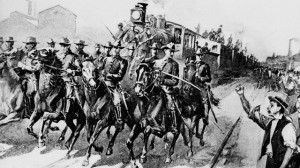
Federal troops escort a train through jeering, fist-shaking workmen on August 20, 1958 in Chicago in this drawing of an incident during the Pullman strike of 1894. (AP Photo)
Over the next century, unions fought to win all sorts of benefits for Americans, ranging from widespread employer-sponsored health care to reduced workdays. But this Labor Day, many of these hard-fought benefits are under attack:
- Pensions: Thanks to federal reforms and labor activism, private sector pension plans proliferated in the twentieth century. In March of 1949, the National Labor Relations Board ruled that companies had to bargain with their unions over pensions. Walter Reuther – the famous United Auto Workers (UAW) leader who also addressed the 1963 March On Washington – demanded that Ford Motor Company offer retirement security in the form of pensions, and led his workers in a strike in order to win it. By September 1949, Ford agreed to a $100-a-month pension – a decision that had huge ramifications for pro-pension activism nationwide.
Today, pensions across the country are under attack. In 1979, 38 percent of workers in the private sector had access to a defined benefit plan. By 2010, only 15 percent had access to such a plan. Meanwhile in the public sector, both state and local governments continue to cut pensions even while handing out massive tax giveaways to corporations.
- The Right To Organize: One right unions gave America is the ability to collectively bargain for better wages, benefits, hours and working conditions. In the 1950s more than a third of Americans belonged to unions; in 1952, there were 470 strikes involving 2.7 million workers. The recent wave of anti-union laws and aggressive anti-labor tactics by businesses has meant that far fewer Americans have been able to join a union. By the end of 2012 only 11.3 percent of Americans were unionized. Today, right-wing politicians have signed laws aimed at undermining collective bargaining in both the public and private sectors.
- Income Equality: As unionization peaked in the middle of the last century, so did income equality. Incomes became “dramatically more equal in the 1940s” and “remained roughly stable through the postwar economic booms of the 1950s and 1960s.” But as researchers at the Center for American Progress found, as union membership decreased, the middle class’s share of national income shrunk at a similar rate.
- Access To Health Care: “The rise of unions in the 1930s and 1940s led to the first great expansion of health care” for all Americans, as labor unions banded workers together to negotiate for health coverage plans from employers. In 1942, “the U.S. set up a National War Labor Board. It had the power to set a cap on all wage increases. But it let employers circumvent the cap by offering ‘fringe benefits’ – notably, health insurance.” By 1950, “half of all companies with fewer than 250 workers and two-thirds of all companies with more than 250 workers offered health insurance of one kind or another.” Today, corporations are cutting health benefits and fighting the implementation of the Affordable Care Act, which unions helped pass.
- Fair Hours: In the late nineteenth century, unions started to call for an eight-hour workday, and on May Day in 1886, over 300,000 Americans went on strike for a shorter work day. Within decades, railroad workers won an eight-hour workday, and by the 1950s, most other workers had 40-hour weeks as well. Before this burst of labor activism, the average workweek for Americans was much longer — in 1870 it was 61 hours.
In the post-WWII era, the average American worker worked less hours than even a French worker, but the trend reversed itself in the 1980s and the last few decades have seen Americans working more for less. During the same time, productivity decoupled itself from wages, meaning Americans were working more hours while not necessarily reaping the benefits – likely another outcome of declining unionization.
While these attacks on workers and their rights have been incredibly damaging, there is reason for optimism. Last year’s massive Chicago teachers’ strike won a number of benefits for both teachers and students. As Allison Kilkenny documented, for the first time in modern American history, labor strikes are becoming a widespread tool for workers in the fast food industry – with strikes in dozens of cities this past week. As workers continue to organize to beat back attacks on American labor rights, they can turn to those workers in the fast-food industry for inspiration. “I know I’m risking my job, but it’s my right to fight for my deserve,” said Julio Wilson, a Little Caesars worker in Raleigh, North Carolina, who dreams of the day his $9-an-hour wage will be large enough to care for both himself and his daughter.


